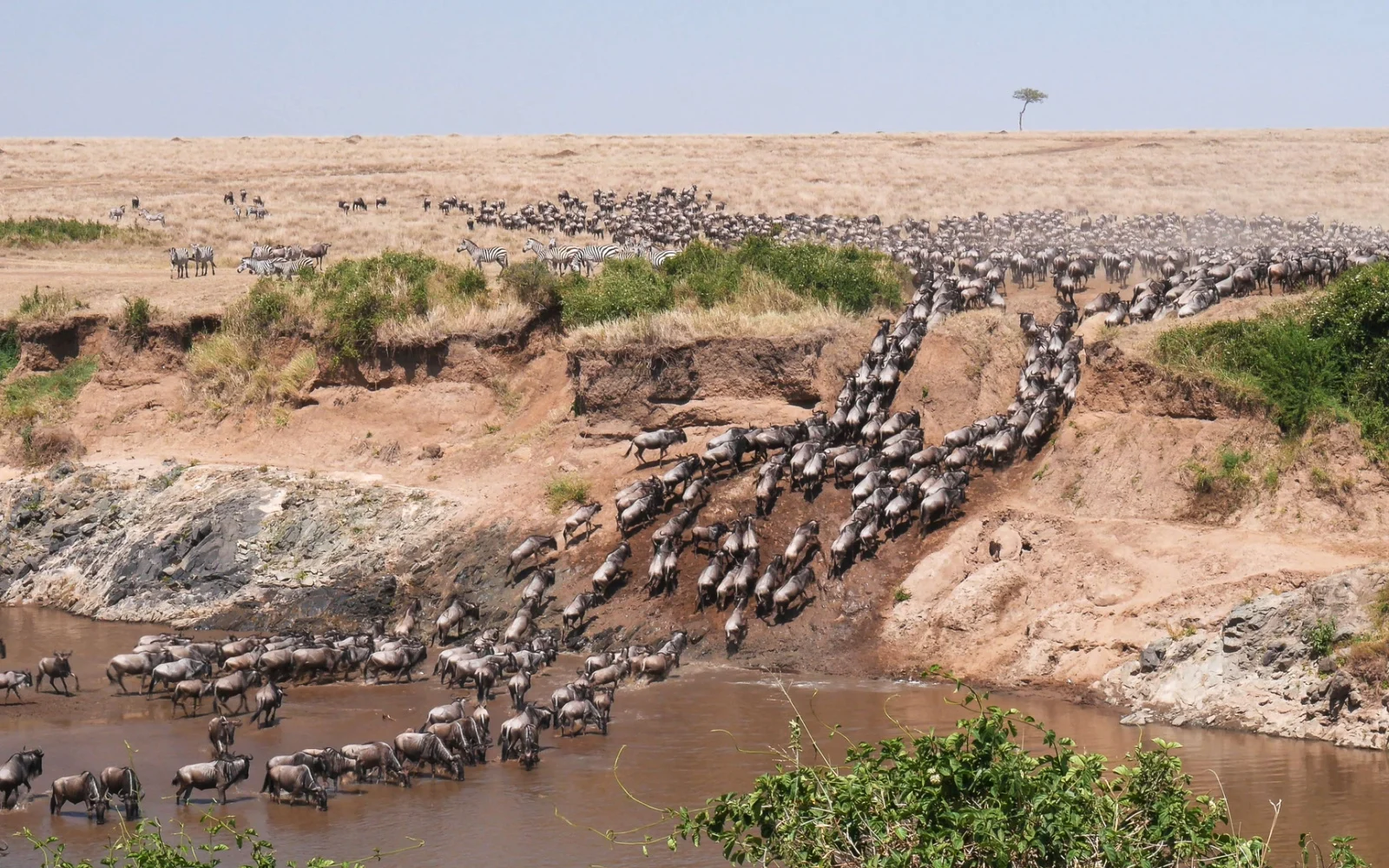The Great Wildebeest Migration is the biggest animal movement on the planet and a must-see event for safari goers. Learn about when, where, and how it happens each year in our guide!
Whether you’re planning on watching it from the massive Serengeti National Park in Tanzania or catching the animals funneling through further north in Kenya’s Masai Mara National Reserve, you’re in for a treat.
We’ll cover the Great Migration, what it is, when it happens, how you can witness it, and how much it costs to watch it below.
What Is the Great Wildebeest Migration?
- Annual migration of wildebeest, gazelles, and zebra
- Up to 2 million animals migrate during this time
- Takes place from late June to November
Every year after the long and short rains pass, Tanzania and Kenya experience the largest animal migration in the world: The Great Wildebeest Migration.
This is when the Eastern white-Bearded wildebeest, or gnus, begin their northwestern movement en masse across the southeastern African savannah and woodlands.
After the yearly rains have passed and dry winter hits the southeastern region of Africa, the plains and woodlands in Tanzania and Kenya dry up, limiting the wildebeests’ food source (grass).
Naturally, they head to the “greener pastures” northwest of their habitat as a group, seeking out lush, wetter areas where the grass grows tall and water is abundant.
The wildebeest migration is a truly magnificent sight to witness. Many people plan their African safari specifically around this event because there’s nothing in the world like it.
What Animals Are in the Great Migration?
During the Great Wildebeest Migration, or the Great Migration, as many as a million wildebeest make their way across the grassy plains and travel vast distances – but they’re not the only ones migrating.
When the white-bearded wildebeest migrate each year, spry Thomson’s gazelles and plains zebra tag along. Up to half a million gazelles and zebra make themselves part of the wildebeest group during the migration each year! They’re also in search of fresh, green grass to eat and water to drink.
How Big Is the Great Wildebeest Migration?
The Great Wildebeest Migration is the largest animal migration in the world. It’s truly massive and you can witness the movement from both Tanzania and Kenya. With about 2 million wildebeest, gazelles, and zebra in tow, the Great Migration is a huge spectacle each year.
The wildlife convoy stretches thousands of miles across the African landscape. The animals naturally align themselves in long columns for the travels for safety. The migration is big enough to make the ground shake under the millions of hooves!
When Does the Wildebeest Migration Happen?
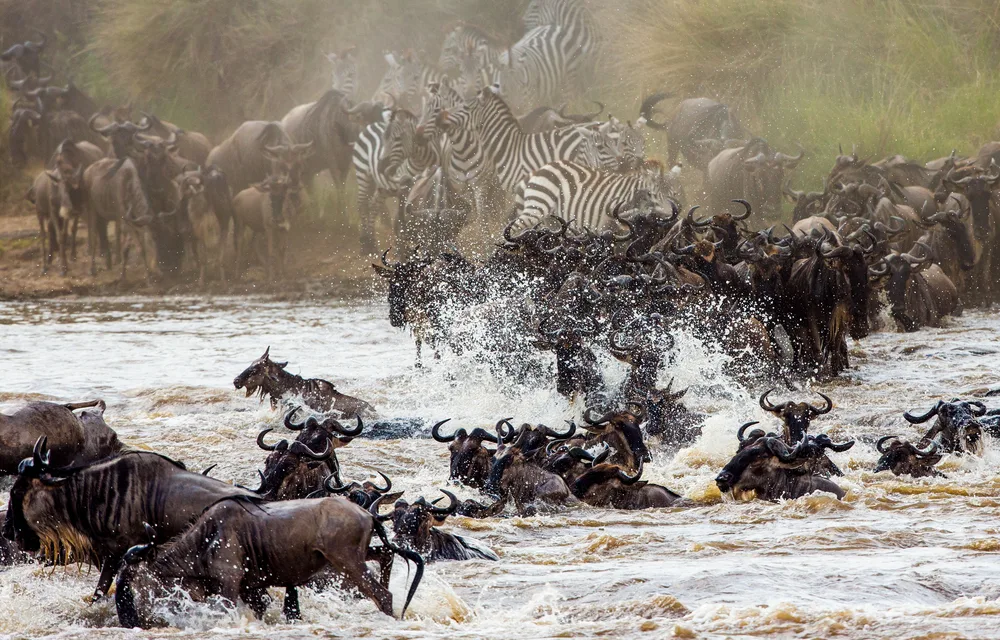
GUDKOV ANDREY/Shutterstock
The wildebeest migration happens during the winter months in southeastern Africa. The general dates are slightly different depending on the region you want to watch it from.
In Tanzania, the Great Migration begins in late June and continues through the month of August. People flock to Serengeti National Park to witness the start of the migration up-close. Soon after, the wildebeest and their gazelle and zebra companions funnel out of the Serengeti and up into Kenya.
The migration kicks off during mid-to-late July and continues through November in Kenya. In Kenya, people visit Masai Mara National Reserve or go on safari there to see the migration taking place.
When Does the Wildebeest Migration End?
Once the wildebeest and accompanying wildlife reach the green pastures and water sources they sought in the northwestern region of Africa, things back home start changing in their favor.
The rains return to southeast Africa in November, fueling the short and tall grasses and refilling favorite watering holes. At the same time, the grasses and watering holes in the northwest begin to dry up as this region experiences a dry season of its own.
As a result, the wildebeest migration loops back with the animals funneling back into Kenya’s Masai Mara National Reserve and Serengeti National Park further south. It’s a beautiful, choreographed cycle that the wildebeest, gazelles, and zebra know well.
How Long Does the Great Wildebeest Migration Last?
The wildebeest migration happens every year in southern Africa and lasts from June through November. The first leg of the migration in the Serengeti National Park takes about 2-3 months (June to August).
The second leg of the migration in the Masai Mara National Reserve takes 3-4 months (July to November). The migration lasts from the time when the grasses and vegetation down south begins drying up at the start of the winter season through the return of the rains sometime in November.
During the migration, wildebeest and other animals move northwest where there’s still plenty of vegetation, grass, and water available.
They all return once those resources are depleted and the grasses are growing again back home. Once they’re settled in again, they’ll begin calving and growing the herd.
Where Can You See the Wildebeest Migration in Africa?
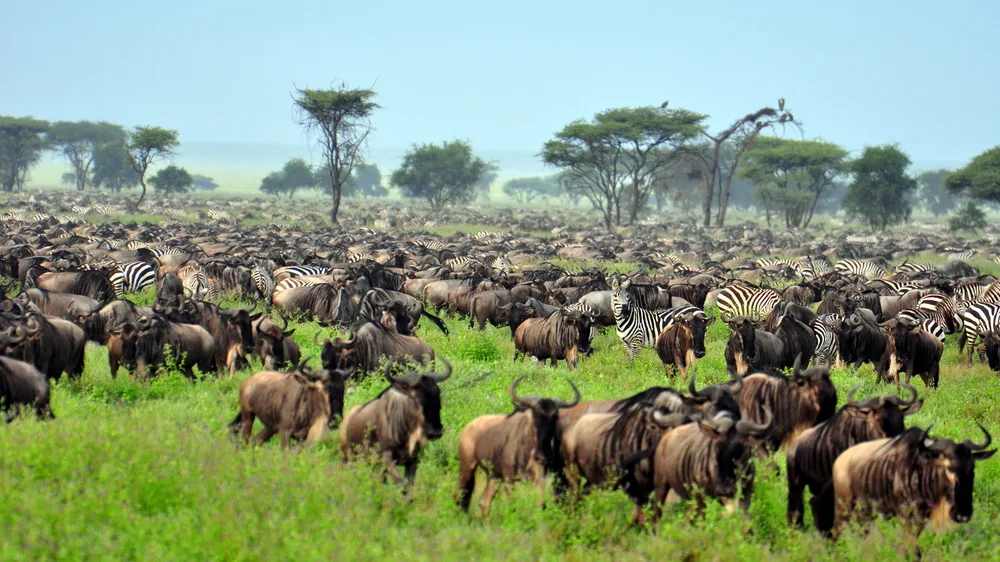
EastVillage Images/Shutterstock
The massive Serengeti National Park in Tanzania is where the Great Migration begins and ends, so head here if you want to see the start of this incredible event.
Plan to arrive sometime in late June through the month of August to catch the mass exodus of white-bearded wildebeest, Thomson’s gazelles, and plains zebra.
To the north, Masai Mara National Reserve in Kenya starts seeing wildebeest, gazelles, and zebra arriving as the animals leave the Serengeti National Park area and travel northwest.
Plan to arrive at the Masai Mara National Reserve in Kenya sometime in mid-to-late July through November to see the bulk of the migration.
How Much Does It Cost to See the Wildebeest Migration?
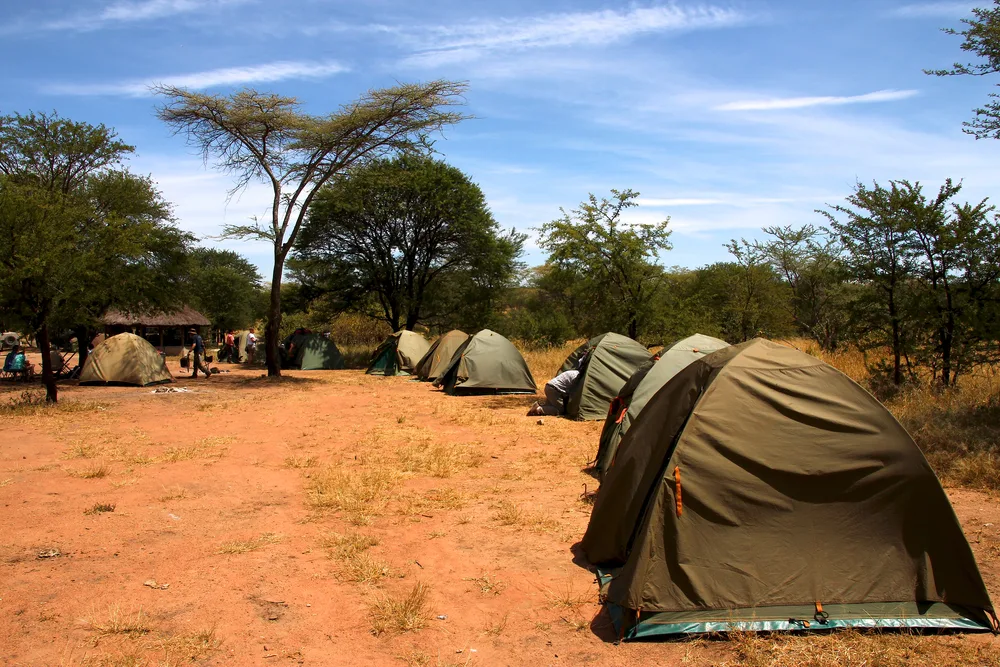
evenfh/Shutterstock
If you’re interested in witnessing the Great Wildebeest Migration for yourself, it’s helpful to get an idea of the general cost.
Typically, most people will choose to either book a safari during the migration or view the migration in parts from Serengeti National Park or Masai Mara National Reserve. Here’s a look at the general costs for each.
Cost to View from a National Park or Reserve
Serengeti National Park and Masai Mara National Reserve charge conservation fees that allow you to enter the park and watch the migration.
Since the migration happens during the high season (which is the best time for a safari), you’ll pay a little more to enter each park or reserve from July to October. If you can go in June (part of the low season), the prices are slightly cheaper.
Serengeti National Park Costs
- High season: $70/day (ages 16+) or $20/day (ages 5-15)
- Low season: $60/day (ages 16+) or $20/day (ages 5-15)
To really get the most out of your experience, you’ll want to camp inside the park. That’s an additional cost that you’ll need to consider.
- Camping high season: $60/night (ages 16+) or $10/night (ages 5-15)
- Camping low season: $30/night (ages 16+) or $5/night (ages 5-15)
The overall cost for an adult to view the wildebeest migration in Serengeti National Park might be $130/day with entrance and camping included.
Masai Mara National Reserve Costs
- High season: $80/day (adults) or $45/day (ages 12 and under)
- If staying within the reserve: $70/day (adults) or $40/day (ages 12 and under)
- Students: $40/day with student ID
Camping fees are not included in the park entrance fees. Here’s what you might pay for camping in Masai Mara.
- Public camping: $30/night (adults) or $20/night (students and ages 12 and under)
- Private camping: $40/night (adults) or $20/night (students and ages 12 and under)
The overall cost for an adult to view the Great Migration from Masai Mara could be $110/day with entrance and camping included.
Cost for a Great Migration Safari
Going on a safari is the best way to witness the wildebeest migration. You can go on safari in one park or reserve or move through the entire migration area. African safari costs vary widely, but paying attention to average costs can help you plan your trip budget.
You might pay anywhere from $125 per person, per day for basic safari excursions with budget accommodations to over $1,500 per person per day to go on a luxury Great Migration safari.
In general, expect to pay around $350-$500/day for mid-tier safari packages that are more robust than basic, but not as fancy as luxury packages.
The length of your safari trip, number of travelers, time of year, and type of accommodations and perks you want included will affect the total cost for a Great Migration safari.
Is the Great Wildebeest Migration Dangerous?
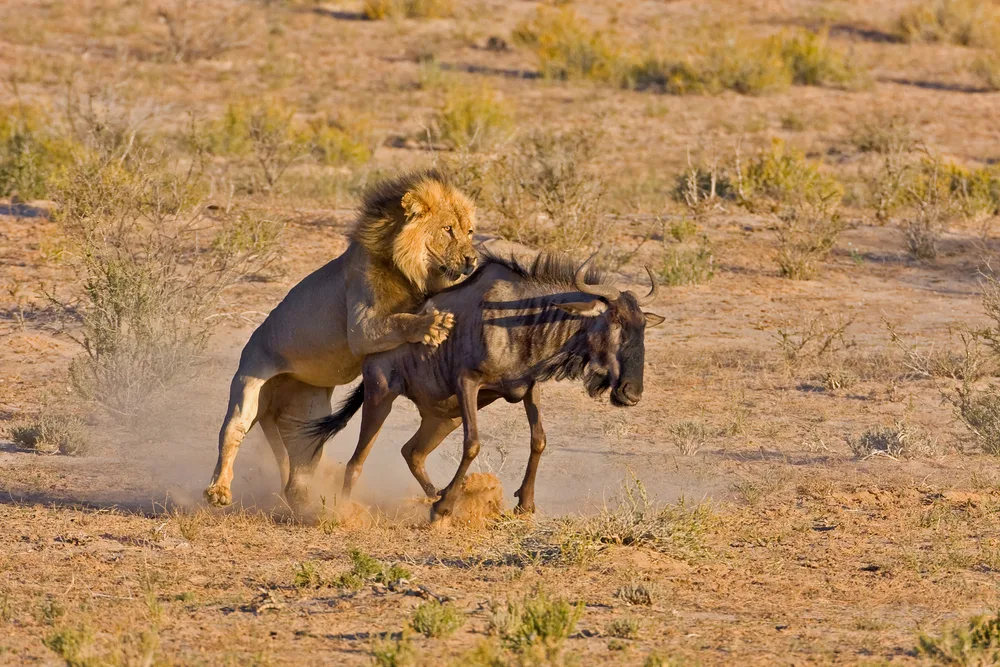
Gerrit_de_Vries/Shutterstock
The wildebeest migration isn’t dangerous for humans to witness, especially from safari vehicles. But plenty of dangers lurk along the journey for wildebeest, gazelles, and zebra migrating!
Hungry crocodiles lie in wait in the thousands in the rivers that the herd must pass on their way northwest. Vicious lions in prides watch carefully for stray, weak, and young wildebeest.
Cheetahs and laughing hyenas are other predators wildebeest will run into along the way. Sticking with the group in the long column formation is their only hope to avoid being picked off.
Aside from predators, the herd can deal with dehydration, starvation, injuries, and drowning during the Great Migration. As a result, thousands of the million-plus wildebeests die during the journey every year. G Adventures cites the annual death toll as 250,000 each year.
So, Is It Worth It to See the Wildebeest Migration?
The annual wildebeest migration in Africa is truly a sight to behold. You’ll be hard-pressed to find anyone who’s witness this event say it’s not worth the trip.
The largest of any animal migration in the world, it’s amazing to watch wildebeest, gazelles, and zebra follow their food source to areas thousands of miles away and loop back every year.
Since the migration is an ancient cycle that happens almost like clockwork, it’s not hard to plan a safari or park visit around it. Plan your trip for June, July, or August if you want to watch the first part of the wildebeest migration in the Serengeti National Park in Tanzania.
If you’d prefer watching the second part of the migration from Masai Mara National Reserve in Kenya, try to arrive sometime between mid-to-late July and November.
Remember to keep your potential costs in mind no matter where you plan to watch the migration from. For Serengeti National Park, you could pay around $130/day per person (with reduced costs for children) during the high season when the migration takes place.
Arriving in June means you can save around $10/day with low season pricing still in effect! For Masai Mara National Reserve, you could pay around $110/day per person (with reduced costs for children).
Masai Mara’s prices are cheaper and don’t fluctuate seasonally like Serengeti’s. The wildebeest migration isn’t something you can fully grasp by watching a nature documentary, viewing pictures, or reading about it.
It’s something you have to witness and experience – and trust us, it’s definitely worth it.



